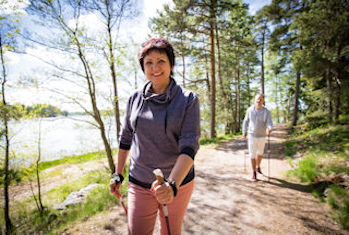Patients and sport

The benefit of physical activity has long been demonstrated and in multiple pathologies (pulmonary, cardiac, cancerous, rheumatic, etc.). Its relevance in neurological diseases is more recently discovered but currently well documented in Alzheimer's and Parkinson's diseases (preventive and therapeutic effect) as well as in multiple sclerosis (therapeutic effect).
It is, in fact, intensive training that is the best stimulus for our brain in constant reorganization, first through vasculogenesis then neurogenesis and finally through dendritic multiplication. Physical activity can break the vicious circle of deconditioning during exercise that follows the symptoms most often encountered in multiple sclerosis (weakness and fatigue) leading to professional and social maladjustment and then psychological decompensation. It can improve muscle strength, mobility, fatigue, depression and, more generally, quality of life.
Ideally, physical activity should be started as soon as the disease is diagnosed and continued uninterrupted. The proposed exercises (aerobic and anaerobic) should be done several times a week. They will be personalized, varied, regularly updated, proactive and meaningful. They will be carried out collectively for motivation and supervised by professionals with a humanist approach centered on the joy of reclaiming one's body. But, above all, these exercises must be the subject of a personal choice with the gradual configuration of their own training by each of the participants. A sporting activity (implying a competitive approach) is in no way contraindicated but deserves specific information.
The keystone of this therapeutic approach, effective at all stages of multiple sclerosis and devoid of any side effects if properly managed, is, let us remember, the early implementation and its sustainability, itself, conditioned by the professionalism of the welcoming structures and the motivation of the people who will supervise patients.
In practice
After a general and basic cardiac assessment, the patient will be evaluated in terms of gait, balance, segmental muscle strength and an EDSS (Expanded Disability Status Scale) score will be established. He will be informed about the importance of hydration (before and after the effort), nutrition (slow carbohydrate 2 hours before the effort) and reassured in the event of the resurgence of a deficient symptom during body warm-up (Uhthoff phenomenon). He will be equipped with a heart rate monitor and will be given a follow-up notebook.
After a push, he will be informed that it is advisable to refrain from any significant physical activity and to resume slowly gradual training afterwards.
Current recommendations
EDSS score from 0 to 3.5 (absence of handicaps to moderate disabilities):
- Aerobic training (endurance): walking, nordic walking, running, running, cycling, elliptical trainer, stepper, rowing machine, gymnastics, swimming,...
- Average heart rate during exercise between 65 and 75% of the theoretical maximum heart rate (210 - age in men, 220 - age in women).
- Objective: 30 minutes without interruption at the rate of 3 sessions per week.
- Anaerobic (resistance) training: global but also analytical, with or without equipment (dumbbells, rubber bands, machines), in static, concentric, eccentric mode and by focusing on the weakest muscles.
- Muscles > 3/5 at the test: 80 to 90% of the maximum force, 5 to 10 reps for 3 to 5 sets of exercises, rest time between sets of at least 3 minutes.
- Muscles < 3/5 when tested: 60 to 65% of the maximum force, 15 to 20 reps for 3 to 5 sets of exercises, rest time between sets double the work time.
- Objective: 2 sessions per week because 2 days of rest between these recommended workouts.
- Classic stretching after each workout, Yoga and Tai Chi as a possible alternative.
EDSS score of 4 to 6.5 (beginning of impairment of ambulation requiring permanent assistance for walking):
- Aerobic training (endurance): same but in “interval training” mode (effort interspersed with periods of relative rest)).
- Anaerobic (resistance) training: same.
- Stretches: classic after each workout, Yoga and Tai Chi as a possible alternative.
EDSS score > 6.5 (not possible to work):
- Aerobic training (endurance): archery, horse riding, cyclodance,...
- Maximum intensity at 5/10 on the modified Borg scale (i.e. a moderate maximum effort experienced as difficult).
- Objective: 3 sessions per week.
- Anaerobic (resistance) training: same but with emphasis on the work of the upper extremities and not exceeding 60% of the maximum force.
- Stretches: classic after each workout, Yoga and Tai Chi as a possible alternative.
Illness is not an anomaly but another way of being alive (Canguilhem)
Dr Olivier Bouquiaux
Fraiture-en-Condroz Neurological and Functional Rehabilitation Center